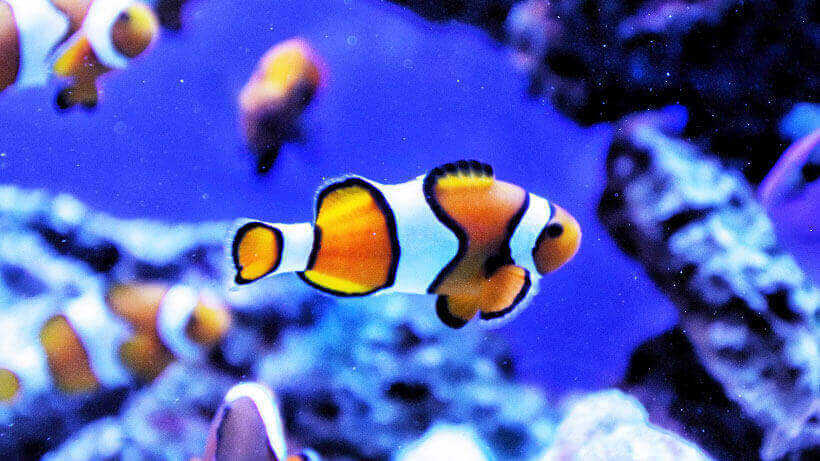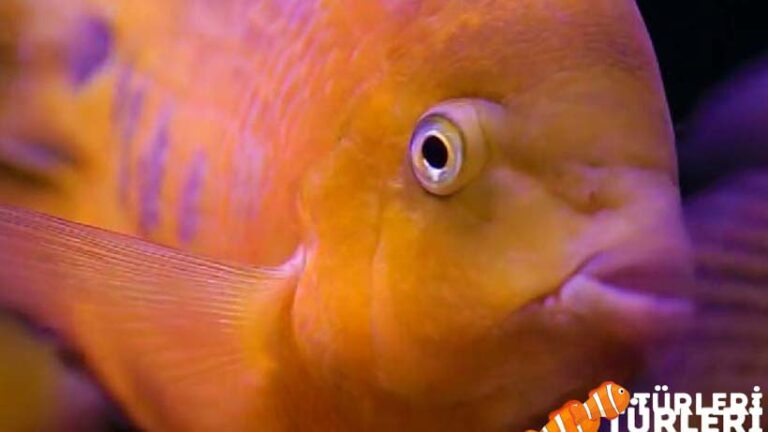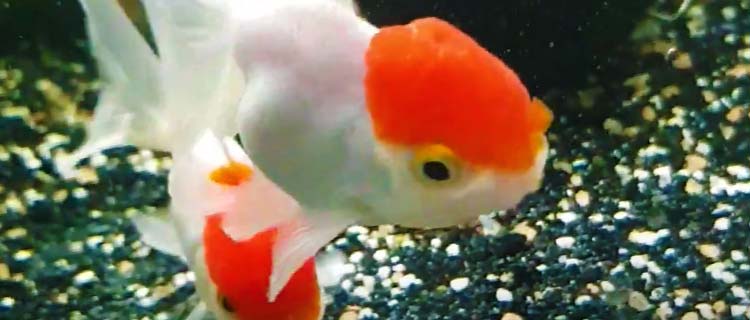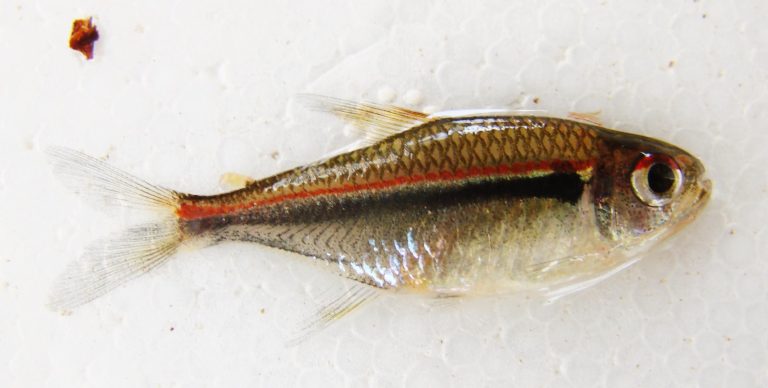Clownfish Guide: A to Z Information
There is a lot of interesting information about clownfish. In this article, we are examining this creature, which we also know from movies and cartoons as the Nemo fish.
Also referred to as anemonefish, clownfish are everywhere. We see them in movies (like Finding Nemo), watch them in documentaries, read about them in magazines and books. But do we know all the facts about these extraordinary and beautiful marine fish?
Are clownfish suitable for aquarium environments? How should they be cared for? What are their characteristics? The answers to many such questions can be found below. Without further ado, let’s delve into detailed information about clownfish.
Clownfish (Nemo Fish) Species Summary
| Other Names: | Anemonefish, Nemo fish |
| Scientific Name: | Amphiprioninae, Amphipron ocellaris |
| Origin: | Indian and Pacific Oceans |
| Diet: | Omnivore |
| Behavior: | Peaceful |
| Behavior Towards Their Own Kind: | Moderately aggressive |
| Swimming Zone: | Mid and bottom |
| Water Temperature: | 24 – 28 °C (75.2 – 82.4 °F) |
| Salinity Ratio: | 1.023 |
| pH Level: | 8.0 – 8.5 |
| Minimum Aquarium Size: | 75 Liters (19.8 gallons) |
| Adult Size: | 10 cm (3.9 inches) |
| Reproduction: | Egg layers |
| Lifespan: | 5 – 6 years (Some species 15-20 years) |
| Care Level: | Easy |
Clownfish Characteristics

It’s undeniable that clownfish rank among the coolest and most flamboyant fish in the seas. Clownfish are members of the Pomacentridae family and predominantly live in regions of Australia, Indonesia, and the Philippines.
There are 30 species of clownfish in the tropical Pacific and Indian Oceans. The name “clown” was given due to the fish’s body color and its thick white stripes that extend vertically. Clownfish are small marine fish that live in tropical climates.
Throughout various periods of history, they have been popular marine aquarium fish adapted by humans. Clownfish are also known as anemonefish because of their close relationship with anemones.
Appearance and Behavior
Clownfish are small fish and grow up to a maximum length of 10 cm (some other species reach up to 18 cm). Among marine fish, they have an average lifespan. The common Amphipron ocellaris species lives about 5-6 years (the lifespan of some species can reach up to 20 years).
These fish have one pair of pectoral fins and two pairs of dorsal fins. The first dorsal fin is large, while the second is smaller and located at the rear of the body. Generally, these fish don’t have anal fins (with some species as exceptions).
Main colors of clownfish include orange, yellow, red, white, and black. Some species have variations on these colors. Depending on the species, their colors and patterns differ. Species distinctions are determined based on color, size, and patterns.
Clownfish are known for their warm-blooded and peaceful behaviors. During challenging periods like reproduction, they can show moderate aggressive behavior towards their own kind. Due to their splendid appearance and friendly attitudes, they are among the most popular fish in marine aquariums.
Natural Habitat
Clownfish live in the temperate waters of the Indian and Pacific Oceans’ coral reefs and the shallow lagoons of Australia and Southeast Asia. Areas with anemones and shallow reefs are their primary habitats. They prefer regions with anemones, especially for protection against currents and dangers, and they live their lives in small shoals.
Sex Differentiation (Sex Change)
Clownfish are hermaphroditic creatures. A hermaphrodite is a term given to organisms that can have both female and male reproductive organs. Hence, sex differentiation in clownfish is somewhat complex.
Depending on the need and the situation within its shoal, a male fish can become female. As they mature, typically the dominant fish becomes female and continues the rest of its life as female. Once a sex change has taken place, there’s no turning back.
When the dominant female in a shoal dies, one of the remaining male fish changes its sex and becomes female. There’s no need to distinguish the sex of clownfish. If you acquire two or more clownfish, one of them will become female. The most distinguishing feature of the female is that they are larger than the male fish.
Which Fish Can They Coexist With?
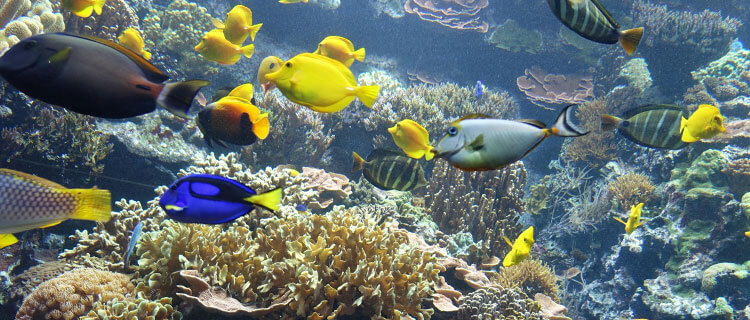
If you’ve decided to set up a marine aquarium, one of the most suitable and easy fish to start with is the clownfish. Clownfish are very mild and peaceful creatures. They can live with many different species in an aquarium environment.
What you need to ensure is to provide a sufficiently large aquarium and the right environment for the species you want to care for.
The species most compatible with clownfish include:
- Mandarinfish
- Red Coris Wrasse
- Pygmy Angelfish
- Crowned Squirrelfish
- Damselfish
- Various Basslet species
- Royal Dottyback
- Yellow Tang
- Banggai Cardinalfish
- Butterflyfish
- Neon Goby
- Pajama Cardinalfish
It’s not very easy to find marine aquarium fish in our country. Therefore, after looking in stores, it’s beneficial to check various forum sites to acquire marine fish.
Clownfish Symbiosis and Mutualism
Symbiosis refers to the intimate and prolonged interaction between two different species. Within this broad category, mutualism stands out as a type where both parties benefit from the relationship. The partnership between clownfish and sea anemones is a classic example of mutualism in the marine world.
Clownfish, also known as anemonefish, and sea anemones have evolved a unique relationship over millions of years. While there are various species of both clownfish and sea anemones, specific pairs tend to form between certain species, showcasing a high degree of host specificity.
The sea anemone, with its stinging tentacles, offers the clownfish protection from potential predators. These tentacles, which can be harmful to most marine creatures, are harmless to the clownfish due to a special mucus layer on its skin. Beyond protection, the sea anemone also provides sustenance to the clownfish. As the anemone captures and consumes its prey, it often leaves behind scraps. These remnants, along with occasional dead tentacles, serve as a food source for the clownfish. Moreover, the anemone’s intricate structure offers the clownfish a safe haven for nesting and laying eggs.
On the other hand, the clownfish offers a range of benefits to the sea anemone. One of the primary advantages is defense. Clownfish are known to be fiercely territorial and will often chase away potential threats to their host anemone. This includes creatures that might feed on the anemone or harm it in other ways. Additionally, the clownfish helps in keeping the anemone clean by removing debris and parasites. Some researchers also believe that the waste produced by clownfish can serve as a nutrient source for the anemones.
In conclusion, the relationship between clownfish and sea anemones epitomizes mutualistic symbiosis in the marine ecosystem. Both organisms benefit from their partnership, ensuring survival and prosperity in their shared environment.
Clownfish Species
There are a total of 30 different species of clownfish. The most common species is Amphiprion ocellaris. Clownfish come in many different colors, but each species has its unique color pattern.
In the table below, we have listed the clownfish species along with their pictures.
| Scientific Name | Name | Picture |
|---|---|---|
| A. akallopisos | Skunk anemonefish |  |
| A. akindynos | Barrier reef anemonefish | 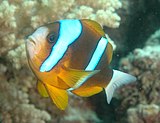 |
| A. allardi | Allard’s anemonefish |  |
| A. barberi | Barber’s anemonefish | 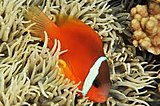 |
| A. bicinctus | Two-band anemonefish | 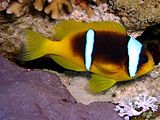 |
| A. chagosensis | Chagos anemonefish | 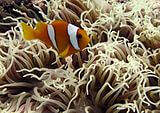 |
| A. chrysogaster | Mauritian anemonefish |  |
| A. chrysopterus | Orange-fin anemonefish | 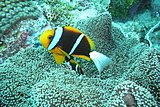 |
| A. clarkii | Clark’s anemonefish |  |
| A. ephippium | Red saddleback anemonefish | 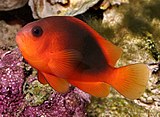 |
| A. frenatus | Tomato anemonefish | 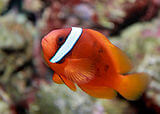 |
| A. fuscocaudatus | Seychelles anemonefish |  |
| A. latezonatus | Wide-band anemonefish |  |
| A. latifasciatus | Madagascar anemonefish | 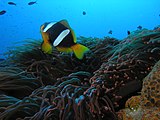 |
| A. leucokranos | White-bonnet anemonefish |  |
| A. mccullochi | Whitesnout anemonefish |  |
| A. melanopus | Red and black anemonefish | 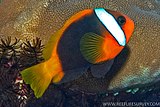 |
| A. nigripes | Maldive anemonefish | 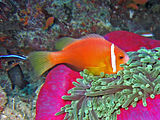 |
| A. ocellaris | False clown anemonefish | 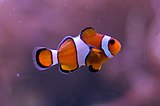 |
| A. omanensis | Oman anemonefish | 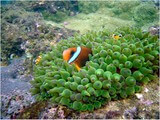 |
| A. pacificus | Pacific anemonefish | 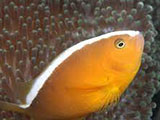 |
| A. percula | Clown anemonefish | 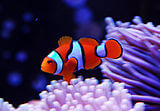 |
| A. perideraion | Pink skunk anemonefish |  |
| A. polymnus | Saddleback anemonefish | 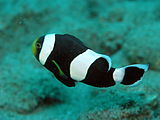 |
| A. rubrocinctus | Australian anemonefish |  |
| A. sandaracinos | Orange anemonefish | 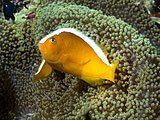 |
| A. sebae | Sebae anemonefish |  |
| A. thiellei | Thielle’s anemonefish |  |
| A. tricinctus | Three-band anemonefish |  |
| Premnas biaculeatus | Maroon anemonefish |  |
Görsel kaynak: wikipedia
Clownfish Care
Clownfish are among the most popular fish species in the saltwater aquarium hobby. They are small, active, colorful, and relatively easy to care for. Clownfish are very hardy and do not require much attention. They can thrive in various aquarium environments. This makes them one of the most suitable fish for those new to marine aquariums.
One of the most important things to pay attention to is their diet. In their natural habitat, clownfish, also known as Nemo, enjoy eating algae that form on rocks and other surfaces. If you wish to spend a long time with your clownfish, providing some of these types of foods in the aquarium environment will help keep them healthy.
Aquarium
Clownfish are active and playful fish. A clownfish aquarium should be large enough for the fish to swim freely. The minimum size for an aquarium should be 75 liters, however, a larger aquarium is always healthier.
The volume of the aquarium is directly related to the number of fish. A 75-liter marine aquarium is sufficient for 2-3 clownfish. If different fish are to be added alongside the clownfish, the volume should be increased accordingly. Since these fish are social creatures, it’s advisable to have at least 4-5 fish.
The ideal aquarium for clownfish consists of a setup with live rocks and live sand (for beneficial bacteria). You can also add other types of saltwater fish, but they should be compatible with clownfish (we listed compatible fish above).
As they are territorial fish, it’s important to create plenty of hiding spots. Otherwise, they might engage in territorial disputes with each other.
If you’re setting up a saltwater aquarium from scratch, this guide will help you:
Water Values
The clownfish is not a demanding species in terms of water parameters. As long as you establish the ideal water parameters and meet the minimum requirements for the aquarium, your fish will be healthy.
Ideal water parameters are; temperature 24-28 degrees Celsius, pH between 8.0-8.5, and salinity between 1.021-1.026.
Feeding and Foods
Clownfish are omnivorous creatures. One of the features that make them an ideal species for those new to marine aquariums is their simple dietary needs. In their natural habitat, they feed on copepods, crustaceans, algae, and fish eggs.
In an aquarium setting, they should be fed with ready-made flake, granular foods, and occasionally live foods. They also happily consume frozen live foods. It’s not suitable to feed them only with prepared and plant-based foods.
How Should Clownfish Be Fed?
For healthy nutrition, adult clownfish should be fed twice a day, young fish three times a day, and juvenile fish four times a day. Moreover, when you’re feeding them live foods, you should give them in small pieces rather than in large chunks.
How Much Food Do They Consume?
There’s no specific measurement for this. The amount of food to be given varies depending on the number and types of fish. Therefore, the most accurate feeding method is a time-based one. When you feed your fish, they should finish all the food within 2-3 minutes. If this isn’t the case, you should consider whether you’re feeding them too much or too little.
Reproduction
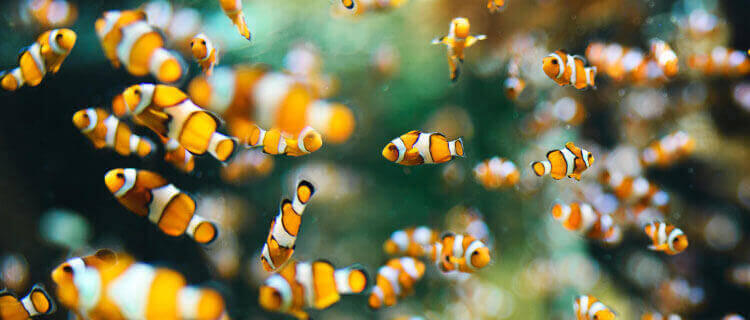
All juvenile clownfish are born as males. They live in small schools made up entirely of male fish, and reproduction is facilitated when the dominant fish in the group changes its sex to become female.
It takes about 2 years for them to reach reproductive maturity. If you start keeping 2 clownfish, as they mature, one of them will undergo a sex change and become female. They should reach the age of 2 before starting the breeding process, but this period sometimes takes longer depending on the species and circumstances.
You can watch the video below to see how clownfish reproduce in the wild.
Clownfish Breeding
If you prepare the correct environment and conditions, clownfish breeding is easy. The things to consider in this context are setting the right water parameters and choosing the correct species for breeding. There are 30 different species of clownfish, and not all species breed with the same ease.
When starting clownfish breeding, you should consider the following:
- A Pair of Clownfish: For breeding, you should select two suitable adult clownfish and place them in the breeding aquarium. As a result of the skirmishes and minor fights that will occur here, the dominant fish will become female, setting the environment necessary for reproduction.
- Breeding Aquarium: After the reproduction has taken place, a separate rearing aquarium is necessary to prevent the adult male and female from eating the eggs or fry.
- Quality and Clean Water: The breeding (fry) aquarium should always have clean water free from waste. Weekly water changes should be performed regularly, and vacuuming the substrate should not be neglected.
- Proper Feeding: During the breeding period, you should provide better nutrition than usual to your fish. They should be fed with live, high-quality foods 2-3 times a day. It’s essential to feed them with foods like shrimp, pieces of fish meat, and fish eggs.
- Encouraging Reproduction: To encourage reproduction, you should give your fish live foods, provide light in cycles that mimic natural periods, and slowly raise the water temperature by 2 degrees (if it’s 25, raise it to 26 the first day, and 27 the following day).
How Many Eggs Do Clownfish Lay?
Depending on their genetic makeup, the aquarium environment they’re in, and their age, clownfish can lay anywhere from 50 to 1,500 eggs. It is also known that as the female fish ages, she can produce more eggs.
1,500 eggs might seem like a lot, but a significant majority of these eggs won’t hatch due to fungal diseases or developmental issues. Even though the male fish’s job is to protect the eggs, you might observe him eating some. The eggs he eats are mostly the bad ones that won’t develop.
How Many Days Does It Take For A Clownfish To Hatch From The Egg?
Clownfish fry will hatch from the eggs between 5 to 10 days after laying and will start swimming freely. Additionally, a few days after these eggs, the female clownfish will produce some more eggs.
Clownfish Diseases
Clownfish, being one of the most popular fish for saltwater aquarium starters, are susceptible to certain diseases, just like other aquarium fish.
Generally, there are 3 common diseases observed in clownfish:
- Brooklynella Disease: This is a deadly disease in clownfish caused by a parasite. By the time its symptoms are visually detected, it’s often too late to treat. The primary symptoms include pale colors, loss of appetite, rubbing against objects, and lethargic behavior.
- Swim Bladder Disorder: Some fish species have an organ called the swim bladder. The purpose of this organ is to help the fish swim properly. When this disease strikes, the fish cannot swim, which affects its mobility and feeding, potentially leading to fatal consequences. More on this: What is the swim bladder problem?
- Fin and Tail Rot: As the name suggests, this is an infectious disease affecting the fins and tail of the fish. The initial symptoms include rotting or melting appearances on the fins and tail. More on this: What is tail rot?
fAQs
Can Clownfish Live in a Fishbowl?
Except for small creatures like aquarium shrimps which have minimal requirements, no fish is suitable for being kept in a fishbowl. Setting up a marine aquarium requires meeting certain conditions, and a fishbowl cannot provide these. Even if it could, clownfish cannot live in a fishbowl.
In Which Water Does Clownfish Live?
The clownfish is a marine creature. To sustain its life, it needs saltwater. The salinity level required for this fish ranges from 1.021 to 1.026
How Long Do Clownfish Live?
Clownfish kept in aquariums typically have a lifespan of 5-6 years. However, it is known that one species of clownfish, Amphiprion melanopus, can live up to 20 years. On average, when looking at all species, the typical lifespan is around 10 years

